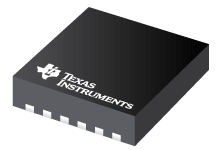Datasheet Texas Instruments TPS54020RUWR
| Manufacturer | Texas Instruments |
| Series | TPS54020 |
| Part Number | TPS54020RUWR |

4.5V to 17V Input, 10A Synchronous Step-Down SWIFT™ Converter with Out-of-Phase Synchronization 15-VQFN-HR -40 to 150
Datasheets
TPS54020 Small, 10-A, 4.5-V to 17-V Input, SWIFTв„ў Synchronous Step-Down Converter With Light-Load Efficiency datasheet
PDF, 2.3 Mb, Revision: D, File published: Dec 12, 2014
Extract from the document
Prices
Status
| Lifecycle Status | Active (Recommended for new designs) |
| Manufacture's Sample Availability | Yes |
Packaging
| Pin | 15 |
| Package Type | RUW |
| Industry STD Term | VQFN-HR |
| JEDEC Code | S-PQFP-N |
| Package QTY | 3000 |
| Carrier | LARGE T&R |
| Device Marking | 54020 |
| Width (mm) | 3.5 |
| Length (mm) | 3.5 |
| Thickness (mm) | .9 |
| Pitch (mm) | .5 |
| Max Height (mm) | 1 |
| Mechanical Data | Download |
Parametrics
| Control Mode | Current Mode |
| Duty Cycle(Max) | 98 % |
| Iout(Max) | 10 A |
| Iq(Typ) | 0.6 mA |
| Operating Temperature Range | -40 to 150 C |
| Package Group | VQFN-HR |
| Rating | Catalog |
| Regulated Outputs | 1 |
| Special Features | Adjustable Current Limit,Enable,Frequency Synchronization,Light Load Efficiency,Phase Interleaving,Power Good,Pre-Bias Start-Up,Synchronous Rectification,Tracking |
| Switching Frequency(Max) | 1200 kHz |
| Switching Frequency(Min) | 200 kHz |
| Type | Converter |
| Vin(Max) | 17 V |
| Vin(Min) | 4.5 V |
| Vout(Max) | 5 V |
| Vout(Min) | 0.6 V |
Eco Plan
| RoHS | Compliant |
| Pb Free | Yes |
Design Kits & Evaluation Modules
- Evaluation Modules & Boards: TPS54020EVM-082
10A Synchronous Step-Down SWIFTВ™ Converter Evaluation Module
Lifecycle Status: Active (Recommended for new designs)
Application Notes
- Designing a negative boost converter from a standard positive buck converterPDF, 267 Kb, File published: Apr 16, 2013
- HotRod QFN Application NotePDF, 356 Kb, File published: Apr 9, 2014
HotRod Quad flatpack No Leads (QFN) are leadless packages specifically designed for power applications. The small footprint, standard QFN pitch, low parasitics along with high current capability of these packages are ideal for power converters application. The electrical connections are made via lands on the bottom side of the component to the surface of the connecting substrate (PCB). This applic - Calculating EfficiencyPDF, 175 Kb, File published: Feb 19, 2010
This application report provides a step-by-step procedure for calculating buck converter efficiency and power dissipation at operating points not provided by the data sheet. - 2Q 2013 Issue Analog Applications JournalPDF, 2.5 Mb, File published: Apr 16, 2013
- SMT Guidelines for Stacked Inductor (Inductor On Top) on Voltage Regulator ICPDF, 409 Kb, File published: Feb 22, 2016
- Understanding Thermal Dissipation and Design of a HeatsinkPDF, 59 Kb, File published: May 4, 2011
Power dissipation performance must be well understood prior to integrating devices on a printed-circuit board (PCB) to ensure that any given device is operated within its defined temperature limits. When a device is running, it consumes electrical energy that is transformed into heat. Most of the heat is typically generated by switching devices like MOSFETs, ICs, etc. This application report discu - Semiconductor and IC Package Thermal Metrics (Rev. C)PDF, 201 Kb, Revision: C, File published: Apr 19, 2016
Model Line
Series: TPS54020 (2)
- TPS54020RUWR TPS54020RUWT
Manufacturer's Classification
- Semiconductors > Power Management > Non-isolated DC/DC Switching Regulator > Step-Down (Buck) > Buck Converter (Integrated Switch)
